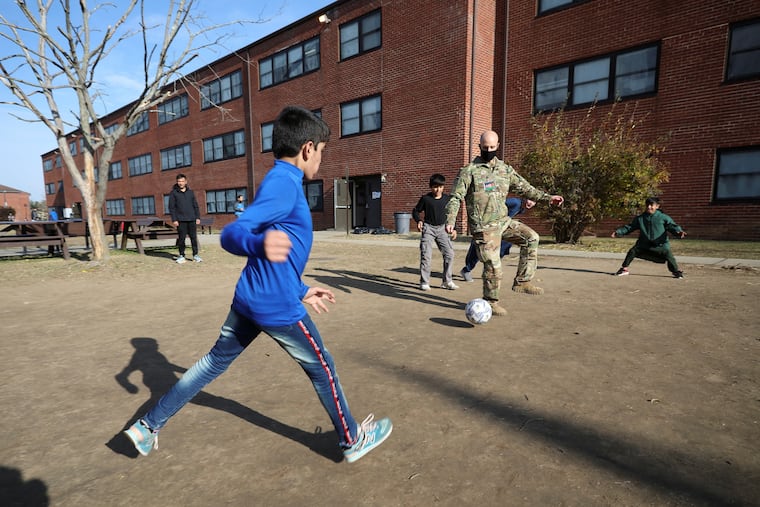At ‘Liberty Village,’ 11,000 Afghan evacuees prepare to confront a New Jersey winter
“We’re full on into winterization,” said Col. Patricia Csank.

In the last four days about 4,500 jackets have been distributed to the Afghan men, women, and children housed at Joint Base McGuire-Dix-Lakehurst in South Jersey.
Fleece and sweatpants were being given out Thursday, soldiers plucking garments from huge cardboard boxes and handing them across tables to families now readying for low temperatures. A shipment of more than 18,000 sweatshirts and sweaters was due to arrive within hours.
Winter is coming. And that’s spurred cold-weather preparations among the 11,000 evacuees, and the federal officials and troops charged with caring for them, on a base that sprawls across Burlington and Ocean Counties.
“We’re full on into winterization,” said Col. Patricia Csank, director of logistics and engineering. “The priorities are food, clothing, and shelter.”
Food preparation has been moved out of New York and onto the base so that a snowstorm can’t cut off access to meals. Nineteen huge housing tents — each holds 512 people — were being hardened for winter on Thursday, their exteriors fitted with solid vinyl siding to keep out the cold of a New Jersey winter.
Today the joint base holds the largest population among the seven U.S. military installations — operations recently concluded at an eighth, Fort Lee in Virginia — that together house about 50,000 Afghans.
“I’m proud of what our team has done here,” said Brig. Gen. Adrian White, adding that the health and safety of “our newest, future U.S. residents” is paramount.
Most of the Afghans on the bases served the U.S. military and diplomatic effort in Afghanistan, or are related to someone who did, evacuated as the Taliban took over the country in August. All await resettlement to communities across the nation.
Most people left Afghanistan with nothing.
“I only brought the clothes that were on my body,” said Mahdi Ahmadi, a 24-year-old former helicopter pilot now among the evacuees at the base.
He’s not worried about the winter cold, he said, because the Americans have given him warm clothes. Along with care and friendship.
“They’re not acting like military,” said Ahmadi, who expects to be resettled in Phoenix. “They’re acting like brothers.”
Ahmadi was one of the evacuees chosen to speak with reporters during a closely monitored press tour of “Liberty Village,” visible in vast scale and complexity. The Afghan enclave is for practical purposes a town located on a military base, complete with its own medical complex, dining facilities, classrooms, and laundry and recreation areas.
The village is roughly the same size as the permanent population of Ocean City, N.J., and three times bigger than Cape May.
Children are everywhere, playing soccer, going to class, walking with mothers and fathers.
“The children, they’re always trying to speak with you and learn a new English word,” said Senior Airman Nikeisha Gibson.
Fully 40% of the evacuees are kids under age 14. About 100 babies have been born on the base since August. The total population is 54% male and 46% female.
The Afghans here belong to different ethnicities, social classes, and religious sects. They come from villages and cities. Some have multiple university degrees, while others never saw a flush toilet until they reached the United States.
Disputes occur occasionally. No one has been charged with a criminal offense, officials said Thursday, which has occurred at other bases.
Afghans are still arriving at the base in small numbers, as they transition from first-stop evacuation centers overseas. About 3,000 people still wait to come to the United States.
On base, older, brick housing is supplemented by what are commonly called tents, though those structures are stronger and more resilient than canvas, and being further insulated now. Their interiors are divided into apartments.
The federal government wants to quickly move people off the military bases and into permanent houses, to get them started on forging new American lives. But that movement, while picking up, continues to be hampered by a tight housing market.
Ultimately more than 700 Afghans are expected to settle in Philadelphia, among more than 1,500 in Pennsylvania. Those who resettle locally could come not just from South Jersey but from other bases as well. New Jersey is expected to settle more than 500 evacuees.
Capt. Ron Miller, who speaks Pashto, one of Afghanistan’s two official languages, said one of the most frequent questions from evacuees is “How do I get my family out of Afghanistan?”
Officials here have no ready answer, beyond offering a referral to U.S. immigration agencies.
“Our guests are also incredibly aware that winter is arriving in Afghanistan,” Miller said. That means their families at home may have trouble finding food and housing.
Food is always available on the base.
Walking paths are being improved, to aid in winter snow removal. And Afghan evacuees are receiving boots, caps, gloves, and sweaters.
“We want to get this warm clothing out to them,” said Col. Bernadette Maldonado, “as quickly as possible.”